
On Sept. 28, 2023, BMW Motorrad celebrated the 100th anniversary of its first production motorcycle (the R 32) by unveiling the latest version of its bestselling motorcycle, the 2024 BMW R 1300 GS. With a pedigree that goes back 43 years to the original R 80 G/S, which introduced the Gelände/Straße (“off-road/road”) concept and started the adventure bike revolution, the R 1300 GS is new from the ground up. Only the butterfly valves and a few bolts and connectors carry over from the R 1250 GS.
Development of the R 1300 GS started six years ago – two years before the R 1250 GS was introduced. Having squeezed as much as they could out of the existing platform, which started with the R 1200 GS introduced in 2004, BMW’s designers and engineers knew that taking the R-series GS into the future and maintaining its position in the market required a clean-sheet design.
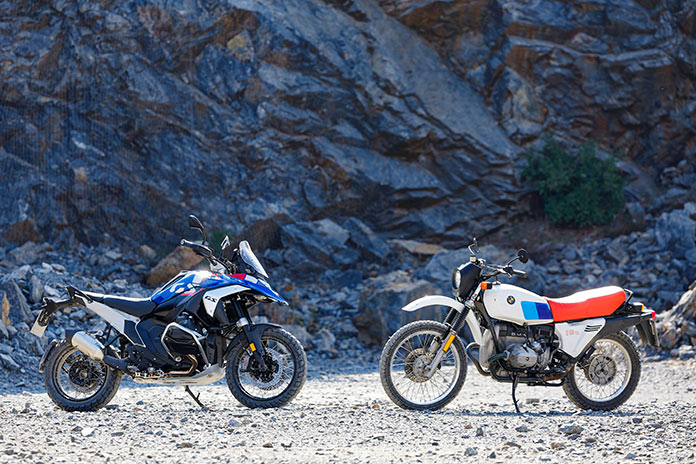
Related: 2021 BMW R 1250 GS 40 Years Edition | Road Test Review
BMW R 1300 GS: New from Stem to Stern
The design objectives were to make the R 1300 GS lighter, more compact, more powerful, and more capable than its predecessor. The only thing that couldn’t change was the engine configuration; the new GS had to have a flat-Twin boxer, but nearly everything else about the engine is new. Displacement increased from 1,254cc to 1,300cc, achieved by a larger 106.5mm bore (up from 102.5) and a new crankshaft that shortened the stroke to 73mm (from 76). Peak horsepower increased from 136 to 145, peak torque increased from 105 to 110 lb-ft, and there’s more torque throughout the rev range, with more than 96 lb-ft available from 3,600 to 7,800 rpm (redline is 9,000 rpm).

GEAR UP
- Helmet: Shoei Hornet X2
- Jacket: Tourmaster Ridgecrest
- Gloves: Tourmaster Overlander
- Pants: Tourmaster Ridgecrest
- Boots: Sidi Adventure 2 Gore-Tex
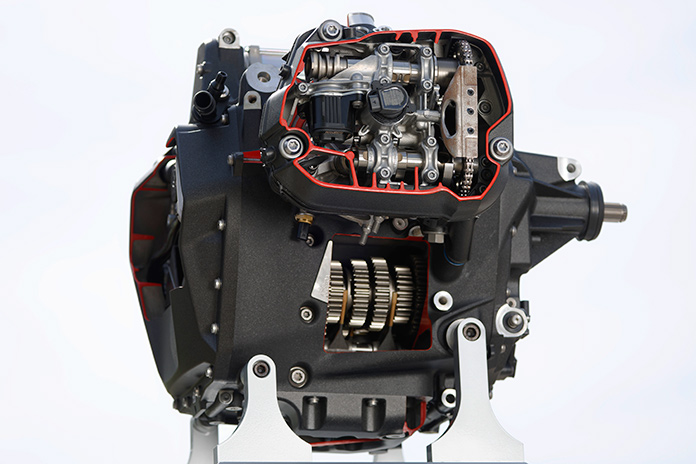
Like its predecessor, the new boxer has air/liquid-cooled cylinders, ShiftCam variable valve timing, and DOHC with four valves per cylinder. The cams are driven by a new timing chain arrangement, with the right cylinder’s timing chain in front of the cylinder and the left cylinder’s timing chain behind the cylinder. Helping achieve the increased power and torque result are revised cam timing, larger valves (44mm intake, up from 40; 35.6mm exhaust, up from 34), and a higher compression ratio (13.3:1, up from 12.5:1).
The R 1300 GS has four standard ride modes: Road, Rain, Eco, and Enduro. Optional Ride Modes Pro adds three additional modes – Dynamic, Dynamic Pro, and Enduro Pro – and the two Pro modes can be customized. Each mode has presets for various standard electronic functions, including throttle response, Dynamic Traction Control, cornering ABS Pro, Dynamic Brake Control, MSR (engine braking torque), and Hill Start Control Pro, as well as optional Dynamic Suspension Adjustment.

Claimed wet weight for the R 1300 GS is 523 lb – 26 lb less than the R 1250 GS. Despite the increase in displacement and power, the engine is nearly 9 lb lighter, while the entire powertrain is more than 14 lb lighter. A new lithium battery shed another 5.5 lb, and reducing fuel capacity from 5.3 to 5.0 gallons saved 1.8 lb. The gearbox was moved under the engine, which was made possible by reducing the number of transmission shafts from three to two. The more compact engine allowed BMW to package everything more tightly and better centralize mass. Even though the engine was moved up to accommodate the gearbox, the bike’s overall center of gravity and weight distribution have not changed.

As part of the GS’s tighter packaging, the previous tubular-steel space frame has been replaced with a precisely formed and laser-welded sheet-metal main frame that uses the engine as a structural component. The tubular-steel subframe has been replaced with a cast-aluminum subframe that is said to be lighter, stiffer, narrower, and more tightly bonded to the main frame. Since the weight of the rider, passenger, and luggage is carried by the subframe, the new design improves stability and riding dynamics.

For three decades, the R-series GS platform has used BMW’s proprietary Telelever front suspension system, which separates suspension forces from steering inputs. The Telelever uses a swingarm that connects the frame to the lower triple clamp through a ball joint. The fork’s stanchions slide within the tubes like on a telescopic fork, but the fork doesn’t control damping; that’s handled by a single central shock between the Telelever’s swingarm and the frame. The tops of the fork stanchions are connected to the handlebar plate via ball joints. As the suspension moves through its stroke, the swingarm moves through an arc, and the upper and lower ball joints compensate for the Telelever’s torsional movement.

The R 1300 GS is equipped with the next-gen EVO Telelever system, which eliminates the ball joints atop the fork tubes and instead uses a metal flex plate between the handlebar plate and the upper triple clamp. The flex plate accommodates the Telelever’s torsional movement but does so with less friction and more stiffness than the ball joints. To further reduce friction, a radial spherical plain bearing connects the upper triple clamp to the steering stem, which is guided within the frame via a cylindrical roller bearing at the top and a deep-groove ball bearing at the bottom. There’s also an extra roller bearing for the ball joint that connects the Telelever swingarm to the lower fork bridge. Increasing the front wheel axle’s diameter by 0.2 inch to 1.0 inch contributes additional stiffness to the front end, and the new axle is 1.7 oz. lighter.
There’s also a new EVO Paralever rear suspension. Moving the gearbox under the engine allowed the single-sided swingarm to be made longer for better traction (wheelbase has increased by only 0.2 inch). The EVO system has a stiffer connection between the rear shock and the frame, and the swingarm bearing is arranged off-axis to the rotation of the cardan shaft joint. The driveshaft has larger universal joints, and a longer rear-axle wheel stub makes it easier to remove and mount the rear wheel.

The optional Dynamic Suspension Adjustment not only electronically adjusts damping depending on suspension mode and conditions, it also automatically adjusts preload to compensate for varying loads. Within the front and rear shocks’ remote reservoirs are secondary springs that allows DSA to use different spring rates for on-road and off-road ride modes.

Two new suspension options are also available. One is adaptive vehicle height control, which lowers seat height from 33.5 to 32.3 inches and can be set to automatically adjust seat height or to stay at the low or high heights. In the other direction, sports suspension, which is designed for aggressive off-road riding, adds 0.8 inch of front/rear travel and firmer damping.
With its sharper beak, more integrated bodywork, and new frame and subframe, the styling of the R 1300 GS is a radical departure from the R 1250 GS, so much so that initial reactions were mixed when we posted an announcement online. While styling is highly subjective, the new GS is best appreciated in person; photos don’t do it justice, and I count myself as a fan of the new look.
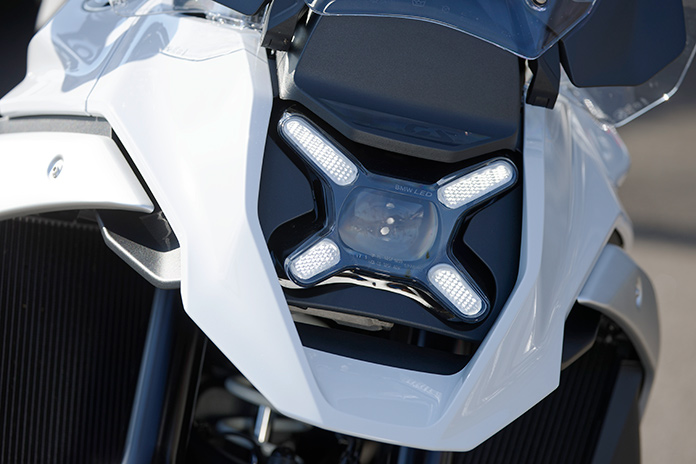
The R 1300 GS has a more aggressive and aerodynamic profile, with a flatter tank and a slimmer tailsection. Perhaps most controversial of all is the centralized X-shaped headlight that replaces the asymmetrical headlight that’s been a signature GS styling element for many years. The new design was guided in part by new homologation requirements but also by a desire to create a distinctive new look that will be instantly recognizable.
Riding the BMW R 1300 GS
We spent two days riding the R 1300 GS on- and off-road for nearly 300 miles at the global press launch in southern Spain. Over the past 15 years, with thousands of miles ridden on intros, road tests, and nearly a dozen overseas tours, I’ve logged more miles on BMW R 1200/1250 GS models than any other motorcycle. Hands down, the R 1300 GS is the best GS yet. The traits that the boxer-powered GS are known for – engine character, balance, comfort, and versatility – are better than ever. It looks and feels much slimmer than before, and the increased power and torque are impressive.

Thanks to the stiffer chassis and new EVO Telelever/Paralever suspension, the R 1300 GS feels more stable both on-road and off-road, yet its steering is lighter and sharper. Whereas the previous Telelever setup offered responsive handling but muted feedback, the EVO Telelever sends clearer signals to the rider through the handlebar.
During our off-road test, we rode the Trophy variant of the R 1300 GS with cross-spoke wheels and Metzeler Karoo 4 tires. Balanced and predictable low-speed handling has long been a hallmark of boxer-powered GS models, and the R 1300 GS chugged along happily on singletrack gravel trails and wooded paths. At higher speeds up and down an unpaved road covered in fist-sized rocks, the GS improved upon what it’s known for: handling better off-road than a bike of its size should. Standing on the pegs felt very natural thanks to the slimmer tank and midsection and 1.2-inch-taller handlebar.
Our off-road test was no more than 10 miles total, primarily just a photo opportunity at an enduro park in a former rock quarry. We made fast runs on gravel, slow runs on rocky singletrack, and chugged up a rocky road to a vista high above the Mediterranean coast – enough for a taste test but certainly well short of a full meal. We’ll have to wait until we get a test bike to do a more thorough assessment of the bike’s off-road prowess.
On-road is where we logged most of our miles, everything from freeways to traffic-choked city roads with slippery roundabouts to a 10-course meal of backroads that snaked from the coast up into the mountains and back down again. The GS was responsive and easy to handle in all conditions, but it really came alive on tight, twisty roads in the Sierra de las Nieves range. I was able to push harder with more confidence, especially with the firmer suspension damping in Dynamic Pro mode.
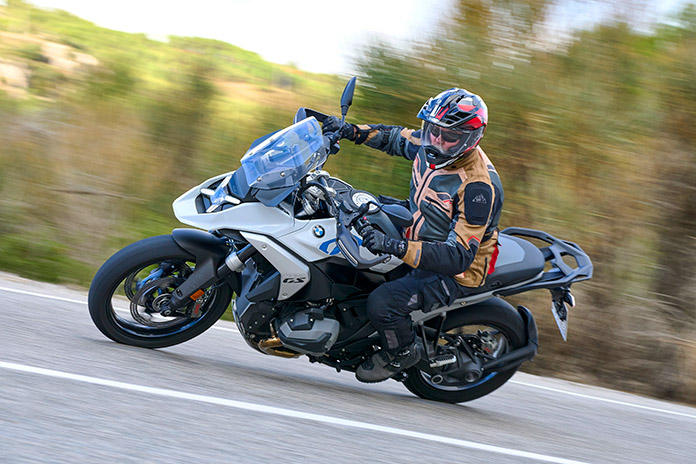
The added power and torque allow the R 1300 GS to launch forward quickly with a flick of the wrist in almost any gear or rpm, yet the bike doesn’t feel edgy or aggressive. The revamped boxer runs more smoothly, which long-distance touring riders will appreciate. Whether light pulls on the lever or hard squeezes, the GS slows down with precision and power, enhanced by the electronic wizardry of cornering ABS and semi-active suspension.

Not only does the new GS handle, accelerate, and stop better than the R 1250 GS, it’s also more comfortable. At 33.5 inches, its nonadjustable seat height is the same as the low position on the 1250. I’m 6-feet tall with long arms and a 34-inch inseam, and the ergonomics of R-series GS models have always suited me. The 1300’s taller handlebar opens up the rider triangle, which I found agreeable whether seated or standing. We tried two different windscreens, the short Sport windscreen and the electrically adjustable windscreen with side deflectors, and both managed airflow well, the latter providing more protection at any height.
BMW R 1300 GS: The Every Bike
State-of-the-art technology has always been an important aspect of the GS. The R 1300 GS has more standard features than before, including the electronic rider aids listed above along with a 6.5-inch TFT with connectivity, tire-pressure monitoring, heated grips, cruise control, handguards with integrated turnsignals, Keyless Ride, a 12V socket, and a smartphone charging compartment with a USB port.
Since the R 1300 GS is the continuation of its bestselling model line, BMW Motorrad tried to ensure that almost any customer preference will be satisfied. Four model variants are available:
- The base model R 1300 GS has a Sport windscreen and a 33.5-inch seat height, and it comes in Light White with a two-tone black/gray two-piece rider and passenger seat.
- The Triple Black variant has a black-on-black color scheme, an electric high windscreen with side wind deflectors, comfort seats, comfort passenger footpegs, and a centerstand.
- The Trophy variant has a red/white/blue Racing Blue Metallic colorway as well as a high rider’s seat (34.2 inches) and a Sport passenger seat that give the appearance of a one-piece rally seat.
- The Option 719 Tramuntana variant has an Aurelius Green Metallic paint scheme and special finishes, a gold anodized handlebar, cross-spoke wheels with gold rims, and a rear luggage rack.

There are three options packages:
- The Premium Package adds lean-sensitive Headlight Pro, Dynamic Suspension Adjustment, Shift Assistant Pro, Riding Modes Pro, Sport Brakes, Central Locking, preparation for navigation, a chrome-plated exhaust manifold, Vario side and top case mounts, handguard extensions, and the new radar-enabled Riding Assistant, which includes Front Collision Warning, Active Cruise Control, and Lane Change Warning.
- The Comfort Package adds an electric high windscreen, a centerstand, a Comfort passenger seat and footpegs, and a luggage rack.
- The Enduro Pro Package adds handlebar risers, engine protection bars, an enduro aluminum engine guard, short enduro handlebar levers, GS adjustable rider footpegs, an exhaust mount for single seat, adjustable foot brake and gearshift levers, large frame guards, and narrower turnsignal stalks.

And there are more than 60 individual options and accessories. Depending on how the R 1300 GS is configured, there are seven seat heights to choose from ranging from 31.5 inches to 35 inches. There are four different suspension options to choose from: Series (manual adjustment), DSA (Dynamic Suspension Adjustment), DSA + Sport Suspension, and DSA + Adaptive Vehicle Height Control. There are different windscreens, footpegs, levers, protection bars and guards, wheels, and a dizzying array of luggage options.
By completely overhauling the R-series GS platform, BMW Motorrad risked alienating some of its core customers and possibly jeopardizing sales of its flagship motorcycle. But it’s also no surprise that the most powerful, capable, and sophisticated R-series GS made its debut during BMW Motorrad’s 100th anniversary. It’s the perfect motorcycle to carry the marque into its next century.
Check out more new motorcycles in Rider’s 2024 Motorcycle Buyers Guide.
2024 BMW R 1300 GS Specs
- Base Price: $18,895
- Warranty: 3 yrs., 36,000 miles
- Website: BMWMotorcycles.com
ENGINE
- Type: Air/oil-cooled, longitudinal opposed flat Twin, DOHC w/ 4 valves per cyl.
- Displacement: 1,300cc
- Bore x Stroke: 106.5 x 73.0mm
- Compression Ratio: 13.3:1
- Valve Insp. Interval: 6,000 miles
- Fuel Delivery: Fully sequential EFI, 52mm throttle bodies x 2
- Lubrication System: Wet sump, 4.2 qt. cap.
- Transmission: 6-speed, hydraulically actuated slip/assist wet clutch
- Final Drive: Shaft
CHASSIS
- Frame: Two-section sheet metal main frame w/ engine as stressed member, cast-aluminum subframe, single-sided cast-aluminum swingarm
- Wheelbase: 59.8 in.
- Rake/Trail: 26.2 degrees/4.4 in.
- Seat Height: 33.5 in.
- Suspension, Front: EVO Telelever w/ single shock, fully adj., 7.5 in. travel
- Rear: EVO Paralever w/ single shock, fully adj., 7.9 in. travel
- Brakes, Front: Dual 310mm floating discs w/ radial-mount opposed 4-piston calipers & ABS
- Rear: Single 285mm disc w/ floating 2-piston caliper & ABS
- Wheels, Front: Cast, 3.00 x 19 in.
- Rear: Cast, 4.50 x 17 in.
- Tires, Front: Tubeless, 120/70-ZR19
- Rear: Tubeless, 170/60-ZR17
- Wet Weight: 523 lb (factory claim)
- Load Capacity: 502 lb
- GVWR: 1,025 lb
PERFORMANCE
- Horsepower: 145 @ 7,750 rpm (factory claim)
- Torque: 105 lb-ft @ 6,500 rpm (factory claim)
- Fuel Capacity: 5.0 gal.



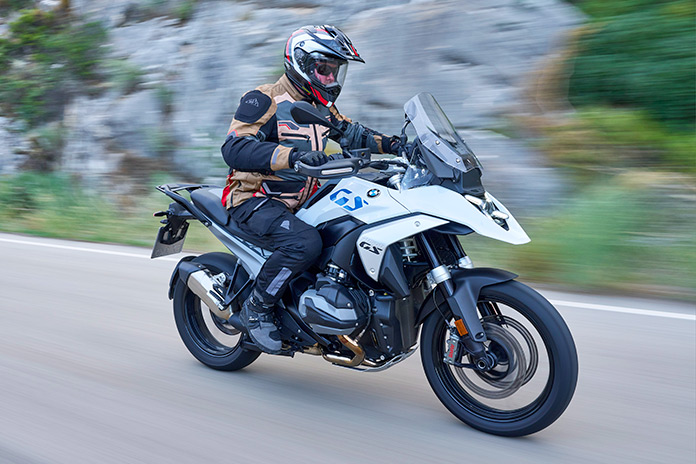




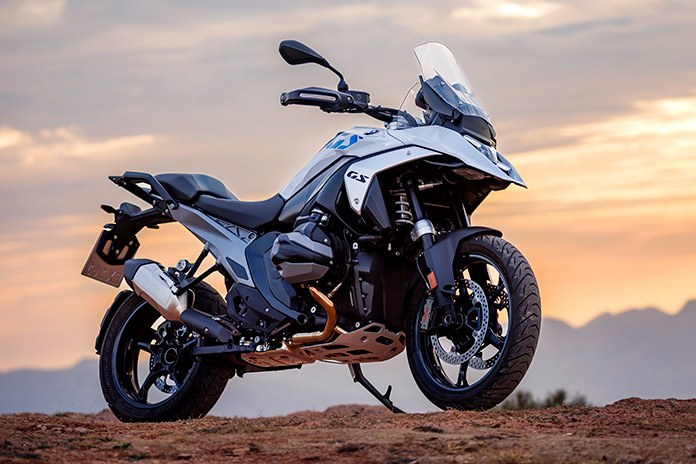







Nice write up. Can’t wait to see a new big ADV bike shoot out.
when did honda make a larger displacment ncx750
Is the person designing the ugly bucktooth front end of the cars also designing the headlight on this bike? Because overall the bike looks great, except for the headlight. And valve “inspections” every 6,000 miles? Far too often, even Ducatis don’t require that kind of service interval any more. Otherwise, looks like a fun big bike. I’ll take that unpronounceable sport touring version, personally.
Don’t believe that 6000 mile valve adjustment is accurate.
Currently double that mileage
And still no backlit handlebar controls.
Is the beak front end going to make unacceptable wind noise like Ducati Multistrada ?
(Increasing the front wheel axle’s diameter from 0.2 inch to 1.0 inch ) You probably meant BY .2 inch. The old one is .8 inch.
Robert, you are correct. Thanks for bringing that to our attention. It has been remedied.
I believe the engine is air/water-cooled
Pretty sure it’s 19” front tire, not 17”, unless this is an alternate dimension.
Yes indeed. Thanks for bringing that to our attention. It has been remedied.
The caption on the fourth picture reads …”EVO Paralever front suspension”. It should read “EVO Telelever front suspension”
Disappointed that one can not get Sport suspension (Enduro pro) etc, or the better breaks without buying the premium package $3,800 extra!
Every test ride says how nice the breaks and suspension are, however nobody is mentioning that only comes with the Premium package!! What I want to know is how this bike will ride without the premium suspension, premium brake and without Enduro pro and all the other fancy upgrade riding modes!!
Would be nice to see some touring reviews, I ride mine many miles before any off rode stuff. Screen looks small for mega mile rides. Oh why put the indicators on the hand guards.
As soon as we get our hands on an R 1300 GS test bike, we’ll be putting some serious miles on it. Electric windscreen with side deflectors works well – that’s included with the optional Comfort Package.
Pretty awesome motorcycle. I wonder how it feels to ride with that 3rd mid shock absorber, looks like a pretty cool innovation.
~ signature: license plate flipper by: https://007Plate.com ~